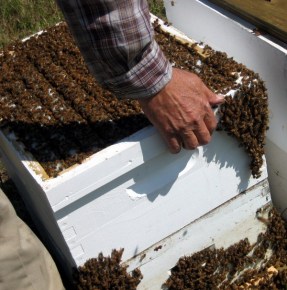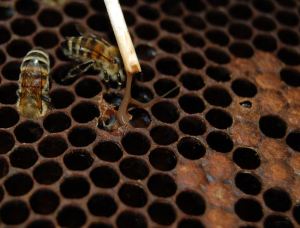 Last week, the popular press was claiming that honey bees discovered vaccines millions of years before humans did. It makes great lead paragraphs for news stories, but the tale is slightly off the mark. Honey bees don’t have scientists. They have queens, drones, and workers. They don’t invent things in the way Discovery.com (Queen Bees Vaccinate All of Their Babies) may have us believe.
Last week, the popular press was claiming that honey bees discovered vaccines millions of years before humans did. It makes great lead paragraphs for news stories, but the tale is slightly off the mark. Honey bees don’t have scientists. They have queens, drones, and workers. They don’t invent things in the way Discovery.com (Queen Bees Vaccinate All of Their Babies) may have us believe.
Even the staid Washington Post gets rather silly on this story: “Humans like to brag about their brilliant advent of vaccinations to prevent diseases, but bees just roll their eyes and shrug. After all, they’ve been doing it naturally for much longer.” I have to admit, the thought of honey bees rolling ten thousand compound eyes in unison made me smile, even if the idea is creepy. So, thanks, Washington Post, for that image.
The news story that bees have developed ‘vaccines’ comes from research (done by humans) published last week in PLOS Pathogens. The three authors title their paper Transfer of Immunity from Mother to Offspring Is Mediated via Egg-Yolk Protein Vitellogenin. You will notice that they do not use the word ‘vaccine’ – probably because we aren’t really talking about vaccinations here. What is happening is that the mother (the queen bee) passes some immunity response through proteins in the offspring egg. It seems that this is not so different from human mothers passing along immunity to human babies. And perhaps not far removed from children acquiring immunity from allegens and bacteria when they are allowed to wallow like pigs in mud. Only once in 12 pages is the word vaccine used – and that’s in the context of potentially maybe someday developing an application using the protein vitellogenin (Vg): “Vg-mediated transfer of pathogenically inactive bacterial fragments could provide a platform for the development of vaccines for beneficial insects.” In other words, humans might make vaccines for insects by feeding inert pathogens to expectant mom-insects who would pass resistance to offspring. Maybe. Someday.
How the immunization process works: In the case of the honey bee, workers encounter pathogens which get mixed into the food they serve to their majesty, which gets into the queen’s liver (actually ‘fat bodies‘ in bees), which combines the pathogen in a protein called vitellogenin, which enters the queen’s blood stream and migrates to eggs as they are laid. This ultimately may give the offspring immunity to some pathogens. But, as we will see, it doesn’t work on one of the honey bees’ worst diseases.
 When you consider that 50,000 individual bees are crammed into a smallish hot damp hive, it is amazing that pathogens don’t decimate colonies within minutes. The discovery of the mother-to-child immunization process may explain how the developing larvae usually survive and mature in conditions that pathogens love. Unfortunately, this does little to alleviate things like foulbrood (AFB and EFB), viruses, nosema, chalk brood, sac brood, nor syndromes such as Colony Collapse Disorder, and mite infestations. However, perhaps there are other pathogens which would thrive in the hive if the vitellogenin-immunization system didn’t exist.
When you consider that 50,000 individual bees are crammed into a smallish hot damp hive, it is amazing that pathogens don’t decimate colonies within minutes. The discovery of the mother-to-child immunization process may explain how the developing larvae usually survive and mature in conditions that pathogens love. Unfortunately, this does little to alleviate things like foulbrood (AFB and EFB), viruses, nosema, chalk brood, sac brood, nor syndromes such as Colony Collapse Disorder, and mite infestations. However, perhaps there are other pathogens which would thrive in the hive if the vitellogenin-immunization system didn’t exist.
The researchers found that gram-negative E. coli is transferred to the egg, but surprisingly, so is Paenibacillus larvae – the gram-positive bacterium causing American foulbrood disease (AFB). Obviously, this transfer system is not stopping the development of AFB, a major killer of honey bees. I am not sure if this means the immunity transfer is not always effective or if Paenibacillus larvae is somehow different. However, the presence of AFB – which will destroy a colony within weeks – suggests that the ‘vaccine’ the queen provides her offspring is far from effective. This implies that the researchers may have discovered the way pathogens can be transferred to offspring – infecting the unborn rather than protecting them. An anti-vaccine, at least in the case of AFB, spreading disease instead of stopping it.
What will become of this research? According to the published paper and subsequent news reports, vitellogenin-mediated transfer of pathogenically inactive bacterial fragments might provide a platform for the development of vaccines for beneficial insects. Or, as in the example of AFB, perhaps some equivalent pathogen could be slipped into a pest insect’s vitellogenin pathway, infecting its progeny and spreading disease among pesky bugs. This might replace pesticides in some cases. The researchers claim, “In sum, such applications could be highly beneficial in agriculture.” It will likely take years to create such applications, but you can be sure someone is working on it at this moment.



Excellent information:)
LikeLike
Thanks – glad you thought so!
LikeLike
Bee hive LIVING in side box
LikeLike